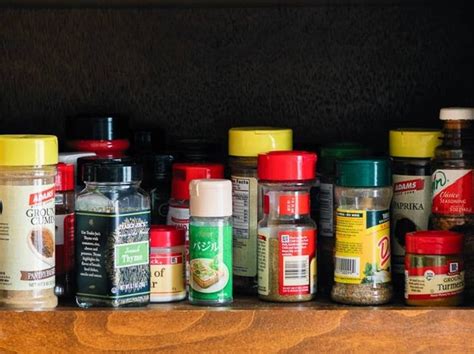
Spice jar lids, often taken for granted, possess a dual-opening design – pour and sprinkle – intended for controlled dispensing, contrary to recent online claims of a newly discovered “secret feature.” While many home cooks may already be aware of this functionality, its resurfacing on social media has sparked renewed interest and discussion regarding proper spice usage and kitchen efficiency.
The purported “secret,” as highlighted in a recent TikTok video that went viral, showcases how spice jar lids typically have two distinct openings: one for pouring larger quantities and another with smaller holes designed for sprinkling. This dual-opening mechanism allows cooks to control the amount of spice dispensed, preventing over-seasoning and ensuring even distribution in dishes. The video’s virality underscores a common lack of awareness regarding this design, despite its widespread implementation across various spice brands and packaging. “For years, people have been using the pour side on their spices when they should have been using the sprinkle side,” the TikTok user claimed, sparking widespread reaction and prompting many to re-examine their spice jars.
However, food experts and experienced cooks emphasize that this feature is neither new nor particularly secretive. Rather, it represents a standard design element intended for practical use in the kitchen. The renewed attention highlights a broader issue concerning basic cooking knowledge and the potential for social media to amplify seemingly trivial discoveries into viral sensations. While the revelation might be eye-opening for some, for many seasoned cooks, it’s a well-understood aspect of spice management.
The dual-opening design offers significant advantages in cooking. The pour side is ideal for recipes requiring larger quantities of a particular spice, such as chili powder in a stew or cinnamon in a baking recipe. Conversely, the sprinkle side is perfect for delicate seasonings, such as adding a light dusting of paprika to deviled eggs or a pinch of herbs to a finished dish. This controlled dispensing minimizes the risk of over-seasoning, a common pitfall for novice cooks. It also allows for more even distribution, ensuring that each bite contains the desired flavor profile.
Furthermore, the sprinkle side can be particularly useful when seasoning meats or vegetables before cooking. By evenly distributing the spice blend, it creates a more consistent flavor crust and prevents clumping, which can lead to uneven cooking and flavor imbalances. The dual-opening design contributes to overall kitchen efficiency by providing options for various cooking needs, streamlining the seasoning process and enhancing the final culinary result.
The online buzz surrounding spice jar lids also raises questions about the effectiveness of product design communication. While manufacturers may assume that users are intuitively aware of such features, the virality of the TikTok video suggests otherwise. This highlights the importance of clear and concise product labeling and user education. Including simple instructions on spice jar lids or packaging could significantly improve user understanding and maximize the intended functionality of the design. Some manufacturers have started incorporating visual cues, such as small icons or descriptive labels, to differentiate between the pour and sprinkle sides. However, further efforts are needed to ensure that all consumers are aware of this basic feature.
Beyond the design of spice jar lids, the conversation extends to the broader topic of spice storage and handling. Proper storage is crucial for maintaining the flavor and potency of spices. Spices should be stored in airtight containers, away from direct sunlight, heat, and moisture. Exposure to these elements can degrade the volatile oils that give spices their distinctive flavor, resulting in a bland and less aromatic product. Many cooks prefer to store their spices in a cool, dark pantry or cabinet, away from the stove or oven. Using opaque containers can also help to protect spices from light exposure.
Additionally, it’s important to use clean, dry utensils when measuring spices to prevent contamination and clumping. Moisture can cause spices to cake together, making them difficult to measure accurately. Regularly checking the expiration dates on spices is also essential. While spices don’t necessarily “go bad” in the traditional sense, they do lose their flavor and aroma over time. As a general rule, ground spices should be replaced every six months to a year, while whole spices can last for up to two years.
The renewed interest in spice jar lids serves as a reminder of the importance of culinary education and attention to detail in the kitchen. Even seemingly minor aspects of cooking, such as proper spice usage, can significantly impact the overall quality and flavor of a dish. By understanding the intended functionality of kitchen tools and ingredients, cooks can enhance their culinary skills and create more flavorful and satisfying meals. The viral trend also underscores the power of social media in disseminating information, both accurate and inaccurate, and its potential to influence consumer behavior and awareness. While the “secret” of spice jar lids may not be groundbreaking news, it has sparked a valuable conversation about kitchen efficiency, product design, and the ongoing quest for culinary knowledge.
The virality of the spice jar lid revelation is also indicative of a larger trend: the democratization of culinary knowledge through online platforms. In the past, cooking techniques and kitchen tips were often passed down through generations or learned through formal culinary training. Today, however, a vast amount of culinary information is readily available online, accessible to anyone with an internet connection. This has empowered home cooks to experiment with new recipes, learn advanced techniques, and discover innovative kitchen hacks.
Social media platforms like TikTok, Instagram, and YouTube have become particularly influential in shaping culinary trends and disseminating cooking knowledge. Short-form video content allows cooks to quickly and easily share tips, recipes, and kitchen hacks with a global audience. The visual nature of these platforms makes it easy to demonstrate techniques and showcase the results of different cooking methods. However, it’s also important to note that not all online culinary information is accurate or reliable. Cooks should be discerning when evaluating online sources and should always verify information from multiple sources before implementing it in their own kitchens.
The spice jar lid “secret” also highlights the importance of critical thinking and fact-checking in the digital age. While the TikTok video sparked widespread interest and discussion, many viewers failed to question the validity of the claim that the dual-opening design was a newly discovered feature. This underscores the need for individuals to be skeptical of online information and to verify claims before sharing them with others. Fact-checking websites and reputable culinary resources can be valuable tools for evaluating the accuracy of online culinary information.
Moreover, the reaction to the spice jar lid revelation reveals the diverse levels of culinary knowledge among home cooks. While some individuals were genuinely surprised to learn about the dual-opening design, others found the revelation to be amusing or even condescending. This highlights the importance of recognizing that not everyone has the same level of culinary experience or knowledge. It also underscores the need for culinary educators and content creators to tailor their messaging to different audiences and skill levels.
The trend also brings up the issue of packaging waste. While the dual-opening lids are functional, they often contribute to the larger problem of plastic waste in the environment. Consumers are becoming increasingly aware of the environmental impact of packaging and are seeking out more sustainable alternatives. Some spice companies are responding to this demand by offering refillable spice jars or using more eco-friendly packaging materials. Consumers can also reduce their environmental impact by purchasing spices in bulk or by growing their own herbs and spices.
In conclusion, while the “secret” spice jar lid feature may not be news to seasoned cooks, its viral resurgence has opened up a valuable conversation about culinary awareness, product design, and the impact of social media on cooking trends. It underscores the importance of clear product communication, critical thinking in the digital age, and the ongoing pursuit of culinary knowledge. It also prompts reflection on sustainable packaging and the environmental impact of everyday kitchen items. The dual-opening spice jar lid, far from being a secret, serves as a small but significant reminder that even the most mundane objects can spark curiosity and inspire learning in the kitchen.
The incident also points to the power of user-generated content. The TikTok video, created by an ordinary user, managed to reach millions of people and generate widespread discussion. This highlights the potential of social media platforms to democratize information sharing and empower individuals to become content creators. User-generated content can be a valuable source of information, entertainment, and inspiration. However, it’s also important to be aware of the potential for misinformation and bias in user-generated content. Users should always critically evaluate the source and content of user-generated material before accepting it as factual.
Furthermore, the spice jar lid phenomenon can be viewed as a microcosm of broader trends in the food industry. Consumers are increasingly interested in understanding the origins of their food, the methods used to produce it, and the impact of their food choices on the environment. This has led to a growing demand for transparency and authenticity in the food industry. Companies are responding to this demand by providing more information about their products, ingredients, and sourcing practices. Consumers are also becoming more interested in supporting local and sustainable food producers.
The discussion surrounding spice jar lids also highlights the role of design in shaping consumer behavior. The dual-opening design is intended to encourage users to use spices in a more controlled and efficient manner. However, the fact that many users were unaware of this feature suggests that the design could be improved to better communicate its intended function. Designers should strive to create products that are not only functional but also intuitive and easy to use. They should also consider the potential for user error and design products that minimize the risk of mistakes.
Ultimately, the spice jar lid saga serves as a reminder that learning is a lifelong process. Even experienced cooks can benefit from staying informed about new techniques, trends, and product features. The culinary world is constantly evolving, and there is always something new to learn. By embracing curiosity, asking questions, and seeking out reliable sources of information, cooks can continue to improve their skills and expand their culinary horizons. The next time you reach for a spice jar, take a moment to appreciate the ingenuity of its design and the potential it holds for enhancing your culinary creations. The humble spice jar lid, it turns out, has more to offer than meets the eye.
The renewed attention on spice jar lids also serves as an opportunity to reflect on the cultural significance of spices. Spices have been valued for centuries for their flavor, aroma, and medicinal properties. They have played a crucial role in shaping cuisines around the world and have been traded and transported across continents for thousands of years. Spices continue to be an integral part of culinary traditions and are used to add depth, complexity, and character to dishes.
The availability and affordability of spices have changed dramatically over time. In the past, spices were often rare and expensive, reserved for the wealthy elite. Today, however, a wide variety of spices are readily available in most supermarkets and grocery stores. This has made it possible for home cooks to experiment with different flavors and cuisines and to create dishes that were once only accessible to professional chefs.
The way we use spices can also reflect our personal preferences and cultural backgrounds. Some cultures favor bold and spicy flavors, while others prefer more subtle and delicate seasonings. The choice of spices can also be influenced by factors such as regional availability, religious traditions, and individual dietary restrictions. By exploring the diverse world of spices, cooks can broaden their culinary horizons and gain a deeper appreciation for the richness and complexity of global cuisines.
Frequently Asked Questions (FAQs):
-
Is the dual-opening design on spice jar lids really a secret?
No, the dual-opening design, featuring a pour side and a sprinkle side, is not a secret. It’s a standard feature on many commercially available spice jars intended for controlled dispensing. While some individuals may not be aware of it, it’s not a newly discovered or hidden function. As the original article suggests, “For years, people have been using the pour side on their spices when they should have been using the sprinkle side,” indicating a lack of awareness rather than a concealed feature.
-
What are the benefits of using the sprinkle side of a spice jar lid?
The sprinkle side of the lid offers several benefits. It allows for controlled and even distribution of spices, preventing over-seasoning and ensuring a more balanced flavor profile. It’s particularly useful for delicate seasonings or when adding a light dusting of spice to a finished dish. This controlled dispensing is crucial to not overwhelming the recipe.
-
How should I store my spices to maintain their freshness and flavor?
Spices should be stored in airtight containers, away from direct sunlight, heat, and moisture. Exposure to these elements can degrade the volatile oils that give spices their distinctive flavor. A cool, dark pantry or cabinet is ideal. Ground spices should be replaced every six months to a year, while whole spices can last for up to two years.
-
Are there any environmental concerns associated with spice jar packaging?
Yes, spice jar packaging, particularly plastic containers and lids, contributes to environmental waste. Consumers are increasingly seeking sustainable alternatives, such as refillable spice jars or eco-friendly packaging materials. Purchasing spices in bulk or growing your own herbs and spices can also help reduce your environmental impact.
-
Where can I find reliable information about cooking techniques and spice usage?
Reliable information about cooking techniques and spice usage can be found in reputable cookbooks, culinary websites, and educational resources. Be cautious of information found on social media, and always verify claims from multiple sources before implementing them in your own kitchen. Look for sources that provide evidence-based information and are authored by experienced cooks or culinary professionals.









